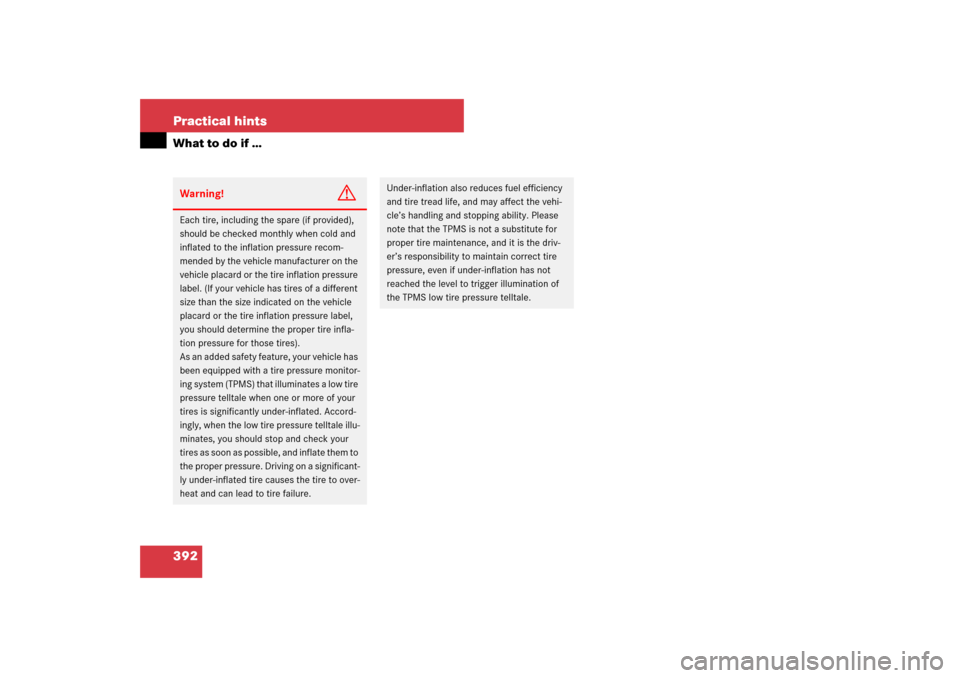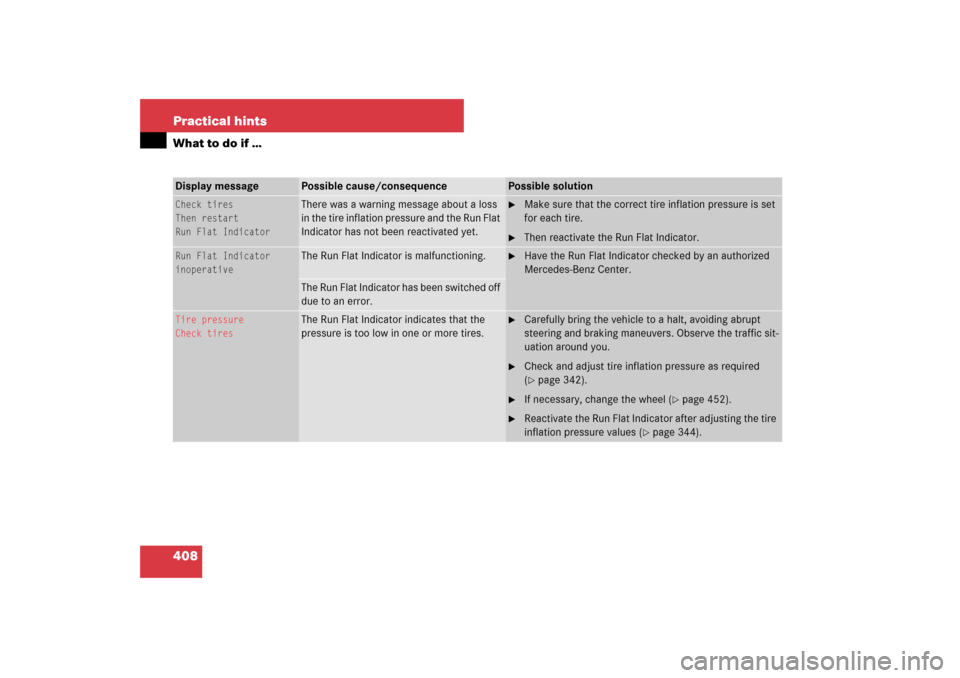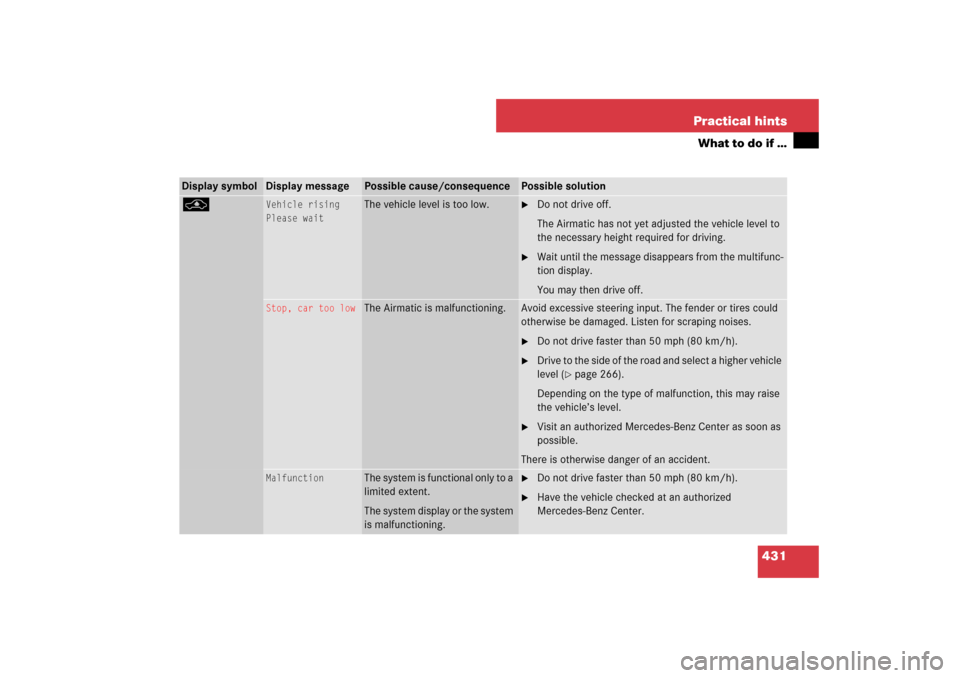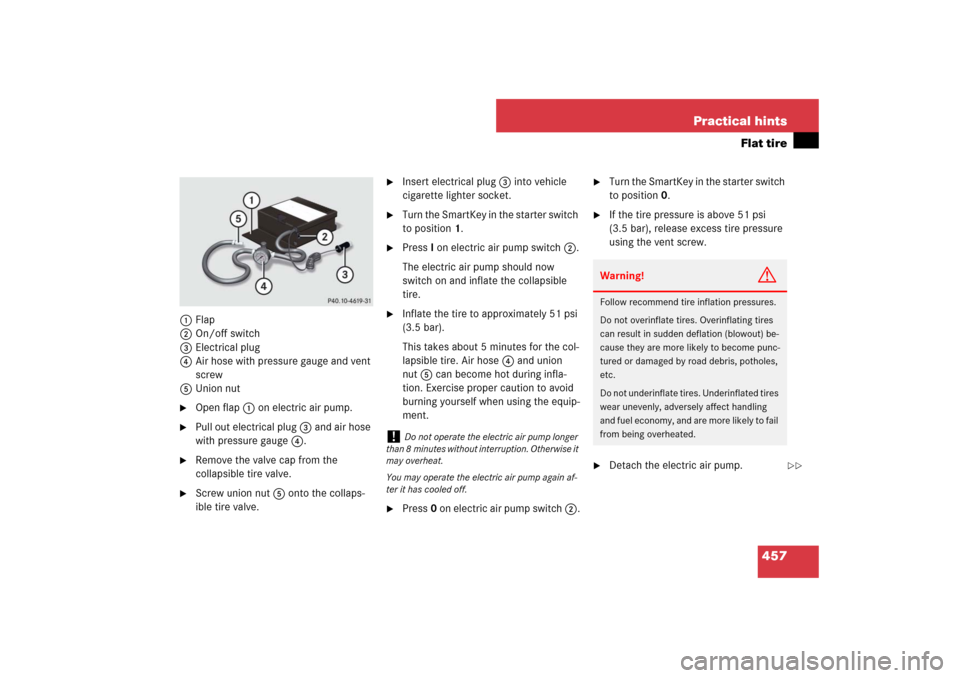Page 371 of 522

370 OperationVehicle careWe have selected car-care products and
compiled recommendations which are
specially matched to our vehicles and
which always reflect the latest technology.
You can obtain Mercedes-Benz approved
car-care products at an authorized
Mercedes-Benz Center.
Scratches, corrosive deposits, corrosion or
damage due to negligent or incorrect care
cannot always be removed or repaired with
the car-care products recommended here.
In such cases it is best to seek aid at an au-
thorized Mercedes-Benz Center.
The following topics deal with the cleaning
and care of your vehicle and give important
“how-to” information as well as references
to Mercedes-Benz approved car-care prod-
ucts.Power washer
Tar stains
Quickly remove tar stains before they dry
and become more difficult to remove. A tar
remover is recommended.Paintwork, painted body components
Mercedes-Benz approved Paint Care
should be applied when water drops on the
paint surface do not “bead up”. This should
normally be done every 3 to 5 months, de-
pending on the climate and washing deter-
gent used.
Mercedes-Benz approved Paint Cleaner
should be applied if the paint surface
shows signs of embedded dirt (i.e. loss of
gloss).
Do not apply any of these products or wax
if your vehicle is parked in the sun or if the
hood is still hot.
�
Use the appropriate MB-Touch-Up
Stick for quick and provisional repairs
of minor paint damage (i.e. chips from
stones, vehicle doors, etc.).
!
Follow the instructions provided by the pow-
er washer manufacturer on maintaining a dis-
tance between the vehicle and the nozzle of the
power washer.
Never use a round nozzle to power-wash tires.
The intense jet of water can result in damage to
the tire.
Always replace a damaged tire.
Always keep the jet of water moving across the
surface. Do not aim directly at electrical parts,
electrical connectors, seals, or other rubber
parts.
i
Vehicles with KEYLESS-GO*:
If a door handle is hit by a strong jet of water, and
a SmartKey with KEYLESS-GO* is in close prox-
imity, i.e. within approximately 3 ft (approxi-
mately 1 m), the vehicle could be inadvertently
locked or unlocked.
!
Affixing stickers, magnets, adhesive tape or
similar materials to painted body components
may damage the paintwork.
Page 393 of 522

392 Practical hintsWhat to do if …Warning!
G
Each tire, including the spare (if provided),
should be checked monthly when cold and
inflated to the inflation pressure recom-
mended by the vehicle manufacturer on the
vehicle placard or the tire inflation pressure
label. (If your vehicle has tires of a different
size than the size indicated on the vehicle
placard or the tire inflation pressure label,
you should determine the proper tire infla-
tion pressure for those tires).
As an added safety feature, your vehicle has
been equipped with a tire pressure monitor-
ing system (TPMS) that illuminates a low tire
pressure telltale when one or more of your
tires is significantly under-inflated. Accord-
ingly, when the low tire pressure telltale illu-
minates, you should stop and check your
tires as soon as possible, and inflate them to
the proper pressure. Driving on a significant-
ly under-inflated tire causes the tire to over-
heat and can lead to tire failure.
Under-inflation also reduces fuel efficiency
and tire tread life, and may affect the vehi-
cle’s handling and stopping ability. Please
note that the TPMS is not a substitute for
proper tire maintenance, and it is the driv-
er’s responsibility to maintain correct tire
pressure, even if under-inflation has not
reached the level to trigger illumination of
the TPMS low tire pressure telltale.
Page 409 of 522

408 Practical hintsWhat to do if …Display message
Possible cause/consequence
Possible solution
Check tires
Then restart
Run Flat Indicator
There was a warning message about a loss
in the tire inflation pressure and the Run Flat
Indicator has not been reactivated yet.
�
Make sure that the correct tire inflation pressure is set
for each tire.
�
Then reactivate the Run Flat Indicator.
Run Flat Indicator
inoperative
The Run Flat Indicator is malfunctioning.
�
Have the Run Flat Indicator checked by an authorized
Mercedes-Benz Center.
The Run Flat Indicator has been switched off
due to an error.
Tire pressure
Check tires
The Run Flat Indicator indicates that the
pressure is too low in one or more tires.
�
Carefully bring the vehicle to a halt, avoiding abrupt
steering and braking maneuvers. Observe the traffic sit-
uation around you.
�
Check and adjust tire inflation pressure as required
(�page 342).
�
If necessary, change the wheel (
�page 452).
�
Reactivate the Run Flat Indicator after adjusting the tire
inflation pressure values (
�page 344).
Page 410 of 522

409 Practical hints
What to do if …
Display message
Possible cause/consequence
Possible solution
Tire pressure is
only displayed
after driving for
a few minutes
Vehicles with Advanced TPMS*:
The tire inflation pressure is being checked.
�
Drive the vehicle for a few minutes.
Tire pressure
monitor
inoperative
The Advanced TPMS* (Canada only) is
malfunctioning.
�
Have the Advanced TPMS* checked by an authorized
Mercedes-Benz Center.
Tire pressure
monitor
inoperative
No wheel sensors
There are wheels without appropriate wheel
sensors mounted (e.g. winter tires).
�
Have the Advanced TPMS* checked by an authorized
Mercedes-Benz Center.
�
Have the appropriate wheel sensors installed by an
authorized Mercedes-Benz Center.
Tire pres. monitor
No wheel sensors
One or more sensors malfunction (e.g. bat-
tery in one or more wheel sensor is empty).
One or more wheels without appropriate
wheel sensors mounted (e.g. spare tire).
�
Have the Advanced TPMS* checked by an authorized
Mercedes-Benz Center.
�
Have the wheel sensors installed by an authorized
Mercedes-Benz Center.
The tire pressure for the respective tire is shown in the
multifunction display.
Page 428 of 522
427 Practical hints
What to do if …
Display symbol
Display message
Possible cause/consequence
Possible solution
H
Please correct
tire pressure
The pressure is too low in one or
more tires.
�
Check and correct tire inflation pressure as
required (
�page 342).
Tire pressure
Caution, tire defect
One or more tires are deflating.
�
Carefully bring the vehicle to a halt, avoiding
abrupt steering and braking maneuvers.
�
If necessary, change the wheel (
�page 452).
Tire pressure
Check tires
One or more tires are deflating.
The respective tire is indicated in
the multifunction display.
�
Carefully bring the vehicle to a halt, avoiding
abrupt steering and braking maneuvers.
�
If necessary, change the wheel (
�page 452).
Warning!
G
Do not drive with a flat tire. A flat tire affects
the ability to steer or brake the vehicle.
You may lose control of the vehicle. Contin-
ued driving with a flat tire will cause exces-
sive heat build-up and possibly a fire.
Page 429 of 522
428 Practical hintsWhat to do if …Display symbol
Display message
Possible cause/consequence
Possible solution
H
Tire pressure
Check tires
The tire pressure in one or more
tires is already below the mini-
mum value.
�
Carefully bring the vehicle to a halt, avoiding
abrupt steering and braking maneuvers.
�
Check and adjust tire pressure as required.
�
If necessary, change the wheel (
�page 452).
Check tires
The tire pressure in one or more
tires is already below the mini-
mum value.
The respective tire is indicated in
the multifunction display.
�
Carefully bring the vehicle to a halt, avoiding
abrupt steering and braking maneuvers.
�
Check and adjust tire pressure as required.
�
If necessary, change the wheel (
�page 452).
Warning!
G
Do not drive with a flat tire. A flat tire affects
the ability to steer or brake the vehicle.
You may lose control of the vehicle. Contin-
ued driving with a flat tire will cause exces-
sive heat build-up and possibly a fire.
Page 432 of 522

431 Practical hints
What to do if …
Display symbol
Display message
Possible cause/consequence
Possible solution
@
Vehicle rising
Please wait
The vehicle level is too low.
�
Do not drive off.
The Airmatic has not yet adjusted the vehicle level to
the necessary height required for driving.
�
Wait until the message disappears from the multifunc-
tion display.
You may then drive off.
Stop, car too low
The Airmatic is malfunctioning.
Avoid excessive steering input. The fender or tires could
otherwise be damaged. Listen for scraping noises.�
Do not drive faster than 50 mph (80 km/h).
�
Drive to the side of the road and select a higher vehicle
level (
�page 266).
Depending on the type of malfunction, this may raise
the vehicle’s level.
�
Visit an authorized Mercedes-Benz Center as soon as
possible.
There is otherwise danger of an accident.
Malfunction
The system is functional only to a
limited extent.
The system display or the system
is malfunctioning.
�
Do not drive faster than 50 mph (80 km/h).
�
Have the vehicle checked at an authorized
Mercedes-Benz Center.
Page 458 of 522

457 Practical hints
Flat tire
1Flap
2On/off switch
3Electrical plug
4Air hose with pressure gauge and vent
screw
5Union nut�
Open flap 1 on electric air pump.
�
Pull out electrical plug 3 and air hose
with pressure gauge 4.
�
Remove the valve cap from the
collapsible tire valve.
�
Screw union nut5 onto the collaps-
ible tire valve.
�
Insert electrical plug 3 into vehicle
cigarette lighter socket.
�
Turn the SmartKey in the starter switch
to position1.
�
PressI on electric air pump switch 2.
The electric air pump should now
switch on and inflate the collapsible
tire.
�
Inflate the tire to approximately 51 psi
(3.5 bar).
This takes about 5 minutes for the col-
lapsible tire. Air hose 4 and union
nut5 can become hot during infla-
tion. Exercise proper caution to avoid
burning yourself when using the equip-
ment.
�
Press0 on electric air pump switch 2.
�
Turn the SmartKey in the starter switch
to position0.
�
If the tire pressure is above 51 psi
(3.5 bar), release excess tire pressure
using the vent screw.
�
Detach the electric air pump.
!
Do not operate the electric air pump longer
than 8 minutes without interruption. Otherwise it
may overheat.
You may operate the electric air pump again af-
ter it has cooled off.
Warning!
G
Follow recommend tire inflation pressures.
Do not overinflate tires. Overinflating tires
can result in sudden deflation (blowout) be-
cause they are more likely to become punc-
tured or damaged by road debris, potholes,
etc.
Do not underinflate tires. Underinflated tires
wear unevenly, adversely affect handling
and fuel economy, and are more likely to fail
from being overheated.
��